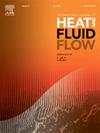Numerical studies on thermophysical process in laser-assisted thermal probe fabrication of nanostructures
IF 2.6
3区 工程技术
Q2 ENGINEERING, MECHANICAL
International Journal of Heat and Fluid Flow
Pub Date : 2025-02-13
DOI:10.1016/j.ijheatfluidflow.2025.109774
引用次数: 0
Abstract
The temperature distribution of both the nanotip and the substrate during thermal scanning probe lithography processing is a critical factor that significantly influences the processing outcomes. The nanotip and the contact area both exhibit a relatively small spatial scale, which presents a significant challenge in accurately measuring the temperature distribution during thermal processing. In this study, finite element simulations are carried out to investigate the thermophysical process between the laser-irradiated nanotip and the PMMA substrate. The temperature distributions of the nanotip and substrate at different contact thermal resistances, apex radii, and vertical loads are investigated. The findings reveal that as the thermal contact resistance rises, the average temperature of the interface between the nanotip and the PMMA substrate diminishes, while it increases with the rise in the vertical load. The maximum average temperature reaches 669.51 K when the laser power and apex radius are 20 mW and 20 nm, respectively. Furthermore, the effective area of heat conduction, delineated by temperatures surpassing the glass transition temperature of PMMA, exhibits a similar trend to the average temperature. The results obtained under various conditions provide theoretical insights for optimizing the process settings of laser-assisted precise fabrication.
求助全文
约1分钟内获得全文
求助全文
来源期刊

International Journal of Heat and Fluid Flow
工程技术-工程:机械
CiteScore
5.00
自引率
7.70%
发文量
131
审稿时长
33 days
期刊介绍:
The International Journal of Heat and Fluid Flow welcomes high-quality original contributions on experimental, computational, and physical aspects of convective heat transfer and fluid dynamics relevant to engineering or the environment, including multiphase and microscale flows.
Papers reporting the application of these disciplines to design and development, with emphasis on new technological fields, are also welcomed. Some of these new fields include microscale electronic and mechanical systems; medical and biological systems; and thermal and flow control in both the internal and external environment.
 求助内容:
求助内容: 应助结果提醒方式:
应助结果提醒方式:


